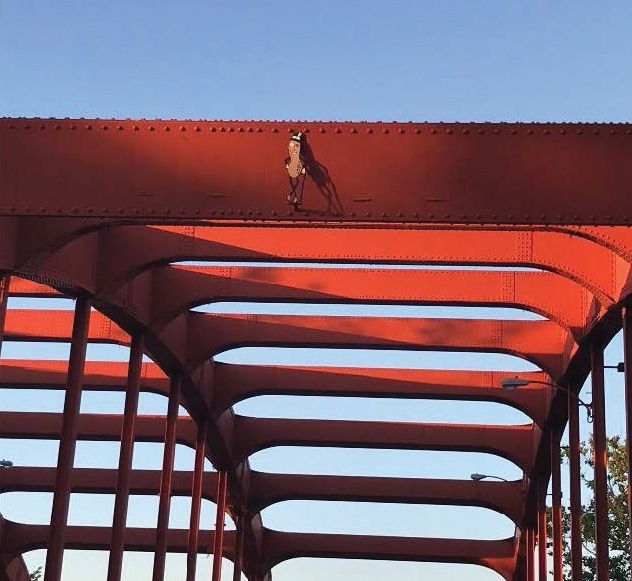
You’ve heard of the beloved spots that everyone says you have to visit when you come to Youngstown: Handel’s for ice cream, the MVR for bocce, and the Butler Institute for some good American art.
But did you know there’s a secret world of hidden treasures in Youngstown – ordinary things and places that can easily go unnoticed but have a fascinating backstory?
I’ve lived in the Mahoning Valley nearly all my life and I have been to all the famous spots, but COVID-19 gave me the time to go beyond the usual suspects, and dig into a whole different world of Youngstown lore that I had never known.
Here’s my list of the top five coolest hidden treasures in Youngstown.
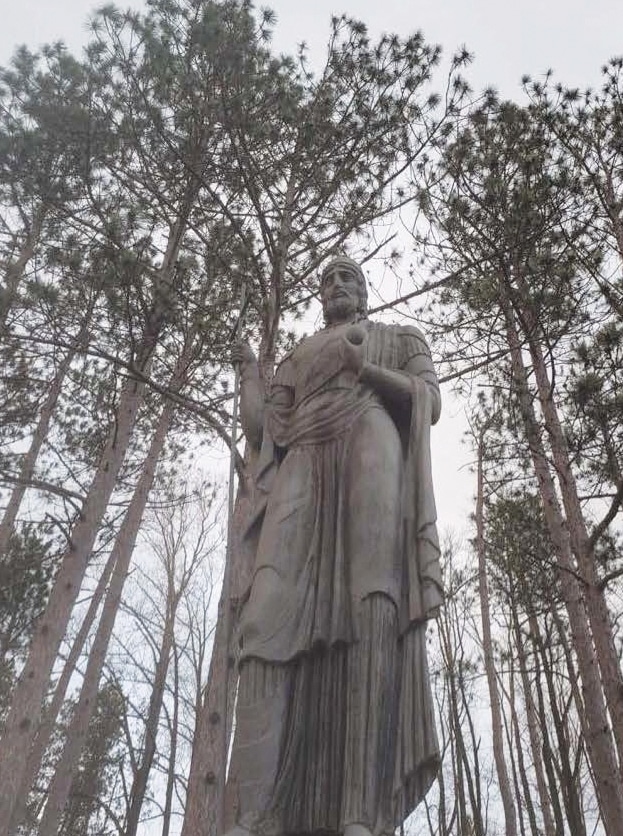
• The St. Stephen Statue – Just off Belle Vista Avenue on Youngstown’s West Side and hidden beneath a stand of tall pines, is a large statue of a man who looks part medieval knight, part Catholic saint, which is pretty much what he is.
The statue depicts St. Stephen, the first king of Hungary, who was born in the year 925. According to an article in the Catholic Exponent, the statue was originally built for the Hungarian Pavilion at the 1939 World’s Fair in New York City.
But as the fair wound down and the Hungarian delegation was getting ready to haul St. Stephen to Europe, World War II broke out, and its caretakers decided it was safer to leave the statue in the United States. A wealthy anonymous patron reportedly purchased the statue and agreed to hold it for safekeeping.
When Hungarians rose up in 1956 against the Soviet Union, which had been occupying the country since the end of the war, a full-scale revolution ensued. Believing the Hungarian Catholic Church was responsible, the Soviets began arresting members of the Catholic clergy.
The arrests prompted a group of Franciscan monks to flee Hungary for Youngstown. They were joined by about 200,000 other Hungarians, all of whom settled in U.S. towns that had plentiful job opportunities, as Youngstown did at the time.
The monks met with Ward Beecher of Youngstown (after whom the Planetarium is named) who sold them the land to create a monastery. Shortly after, the statue’s caretaker donated it to the monks.
St. Stephen was joined by another monument that honored the freedom fighters of the Hungarian Revolution, the “Iron Curtain Stations of the Cross.” The one-of-a kind monument blends scenes of Christ’s crucifixion with the suffering of Hungarian people under Communism, with transcriptions in English and Hungarian.
The whole complex has become a beacon of hope to people of many faiths and those seeking peace and solace in its tranquil setting. It’s even illuminated at night, thanks to Rocky Ridge Neighbors, a local nonprofit that tapped nearby maple trees and sold the syrup to pay for a light installation.
My favorite time to visit this hidden treasure is early morning. That’s when a mist hangs gently around the pine trees and it becomes a quiet, restful place of meditation.
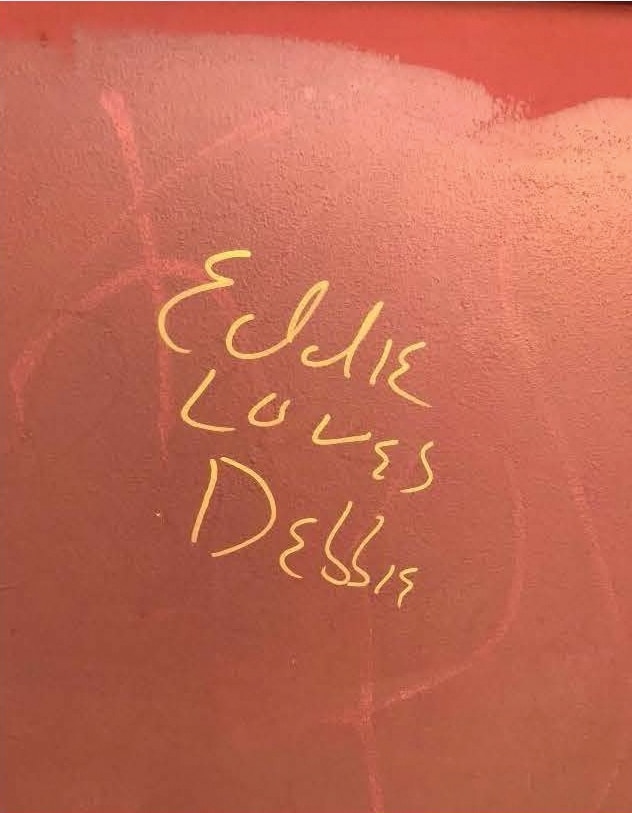
• Eddie Loves Debbie – O.K., so this one isn’t one place, but a whole bunch of places – the side of a bridge, a telephone pole, a gas station pump, a park bench, and probably many other locations.
What makes them special? Pretty much nothing, except for one phrase. It’s written in instantly recognizable, swirly, and, perhaps, manic script: “Eddie loves Debbie.”
The motif started appearing about two decades ago in otherwise mundane outdoor spots throughout the city. But like a Youngstown version of the artist Banksy, Eddie never desired for his, or Debbie’s, identity to be revealed, only his seemingly undying love for her.
Over the years, many have come forward claiming to be the real Eddie or Debbie, but none have been able to make a clear claim as The Ones. It’s left the field of possibilities open for who they might be, and theories abound.
One theory holds that Eddie was drafted during the Vietnam War. Believing he was dead, Debbie moved on and married another man. Upon his return and broken from the war, Eddie went mad with grief realizing his love no longer felt the same way. His only solace was scrawling the phrase obsessively wherever he could, hoping she might one day see it and return.
Another theory claims that Eddie came from an old-school Italian family on the North Side and Debbie came from a Dominican group that had settled in the Campbell area. Love between the two groups was forbidden, and Eddie’s family made every attempt to squash the romance. But Eddie would write the note at a spot indicating where their next secret meeting together should be.
Whoever the real Eddie and Debbie were, they’ve now become Youngstown’s most mysterious and famous love story.
Even after the original Eddie Loves Debbies get painted over (by some jerk), they mysteriously reappear, indicating that either old Eddie is still up to his tricks, or others have taken up the torch.
It would take a long time to track down every instance of “Eddie loves Debbie,” but you can find one on the Fallen Firefighters Memorial Bridge on Mahoning Avenue. It’s been written on the arches of the bridge about 10 times. Since the bridge is painted rust-red, the black Sharpie of the love note really stands out, making for a great photo opportunity.

• The Mr. Peanut Bridge – Built in 1949, the 300-foot bridge spans a lazy, narrow stretch of the Mahoning River. Apart from its rust-red color, it’s fairly unremarkable.
It’s only when you squint hard and look up at the top beam that you see it. An 18-inch tall, yellow-and-black image of the Planter’s mascot, Mr. Peanut, has been attached to the top of the bridge, his monocled and smiling face greeting the cars below.
Little is offered by way of explanation as to how, or why, the dapper legume got there. In a 2007 interview on WFMJ, Mahoning County Engineer Richard Marisco said an ironworker tacked the peanut to the bridge at the end of the project, as a joke aimed at another crewman who allegedly ate tons of peanuts.
But UA Local 396 (the United Association of Union Plumbers, Fitters, Welders and HVAC Techs) has a slightly different take. They say that two of their members, Dick Tranick and Jim Mansky, welded the peanut figure onto the bridge as they were laying a pipeline across the bridge in the summer of 1986. It was meant to be a tribute to their friend and co-worker John Cashbaugh, who apparently came up with “nutty” solutions to solving problems.
In 2007, when the bridge was undergoing renovations to prepare for its new status as the Fallen Firefighters Memorial Bridge, Mr. Peanut was temporarily removed. But public outcry was so strong that he swiftly returned, and when the bridge officially reopened, a life-size, costumed Mr. Peanut attended the re-opening ceremony.
The best way to appreciate the “Peanut Bridge” is around sunset, when the light is angled just right for the biggest contrast between the yellow of the peanut and the red of the bridge. Stand across the street next to the bust of John Young (founder of Youngstown) for an even more Youngstownian experience.
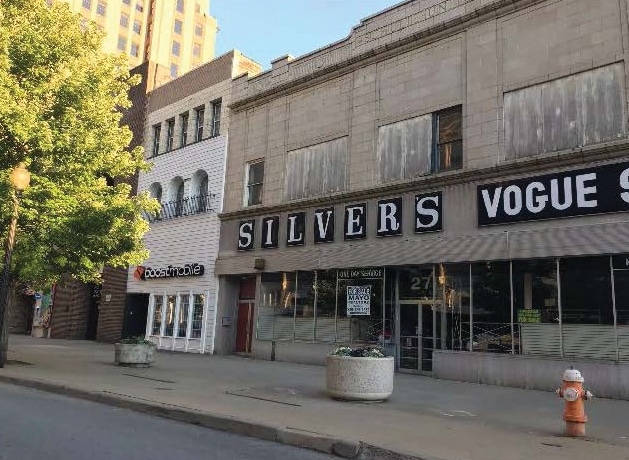
• The Secret Art Studio of Jim Pernotto – Until very recently, Silver’s Vogue Shop was the only landmark you could use to pinpoint the hidden studio of one of Youngstown’s most legendary artists.
When Silver’s Vogue closed in March, it removed the last seeming indication that anyone was in the space at all. But the spot above Silver’s is alive with energy – the creative energy of Jim Pernotto.
Quiet and mild-mannered, Jim is just as disarming as the building in which he creates. Which is why, when one gets the chance to be invited up to the second story loft that houses Pernotto’s studio, one is struck with massive surprise.
The studio is a wild, passionate, eclectic celebration of art in all its forms. The huge space is filled with metallic geometric shapes adorned with lights, Rorschach-style pencil sketches, easels, canvases, hard hats, sculptures contorted into bizarre shapes, and massive murals slathered in bold reds and stormy blues. One of the most noteworthy paintings? A colossal mural entitled “The Passion.” It depicts a stylized image of Youngstown’s steel-producing skyline interposed with a depiction of the crucifixion of Jesus, the agony of both clearly visible.
Pernotto is an American contemporary artist, whose works have been described as “post-post-modern Arte Povera.” His work encompasses painting, sculpting, book artistry, print-making, paper-making, and architectural design. He’s also a self-titled “Existential Subliminal Subversive.”
Beginning his professional art career as the founding director of the Pacifico Gallery in Greenwich Village, Pernotto went on to be a curator with The Butler Institute of American Art. After that, he took on roles teaching at both Youngstown State University and Penn State University.
All that time though, he has remained a creator, and his studio has been the home of his creations. Even as Youngstown experienced its collapse and faltering rebirth, Pernotto has remained a lantern of culture and art in a town that is more typically associated with steel and grit.
While Pernotto’s studio isn’t open to the public, you can connect via his Instagram page. If you do and ask nicely, he might be open to giving you a peek of the space.
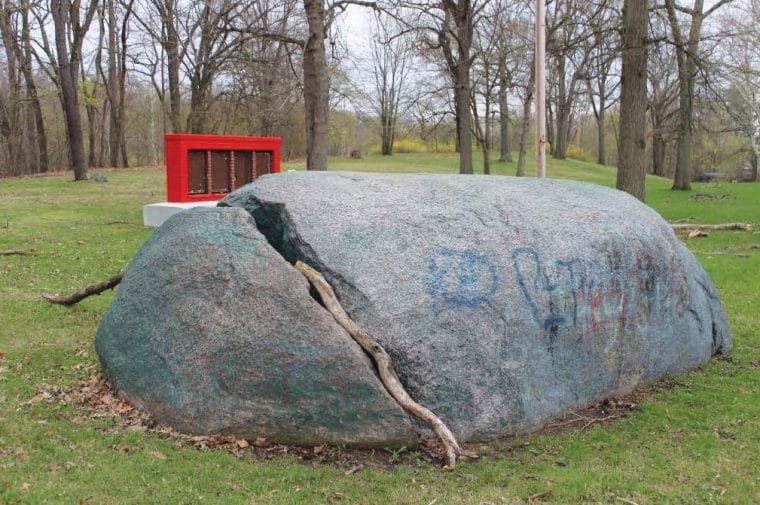
• Council Rock – This is probably the one I recommend visiting the least, since it’s fairly underwhelming in person, but the story behind it is fascinating, and possibly represents Youngstown’s oldest urban legend.
At the entrance to Lincoln Park on Youngstown’s East Side stands a large boulder, about the size of a small car. With no other boulders like it anywhere nearby, it seems out of place in the otherwise open field. Another strange thing about the rock? A giant crack that runs down one side, rending the boulder nearly into two.
Joseph G. Butler, the Youngstown industrialist and founder of the Butler Institute of American Art, also wrote “History of Youngstown and the Mahoning Valley, Ohio” in 1921, which recounts the legend that was told to him by pioneer settler William G. Conner, who was, in turn, told the legend by a fur trapper back in 1865.
According to the legend, Native Americans had gathered in this gorge, as was their annual custom, for a council and feast, when a violent storm occurred. Many trees were blown down and the rock was split by a terrific bolt of lightning, killing many of those who had taken refuge near it. The legend is supported by the unusual appearance of Council Rock, evidently riven in twain by some great force. It is also alleged that the earliest settlers here found an unusually large Indian cornfield on the land along the river at the mouth of this gorge.
Butler goes on to say that the Native Americans, fearful that the Great Spirit had grown angry with them, forsook Council Rock altogether and never used the site as a feasting ground ever again.
There’s no way to prove the story, but if you go to the rock today, it does seem to have a spooky quality. Maybe it’s the way the trees darken the area, but something about the site did feel mildly unsettling when I was there.
The legend of Council Rock is preserved in a 110-year-old painting that hangs in Judge John M. Durkin’s courtroom in the Mahoning County Courthouse. I recommend checking out all the artwork in the courthouse; it’s beautiful!
Youngstown has a rich, storied past. But with the ups and downs of that story, small remnants of that past have been left behind. These relics, hidden gems in plain sight, are a reminder of what Youngstown has been and will continue to be: a melting pot of cultures, a place that honors hard work and humor, and a setting for passion, romance, and creativity. And now that you know their histories, you can go check them out yourself.
***
Metro Monthly is a local news and events magazine based in Youngstown, Ohio. We circulate throughout the Mahoning Valley and offer print and online editions. Be sure to visit our publication’s website for news, features and community events. Office: 330-259-0435.
© 2020 Metro Monthly. All rights reserved.





There is a room under the peanut bridge above the river. Looks abandoned. Anyone know what it was for?
Hi Pat,
Thanks for the email. I suspect the building was related to the railroad industry, but let me check with a local historian.
Did you know that just decades ago northeast Ohio was known for its crime and Mafia connections?
One town in particular was crawling with gangster activity in the mid to late 1900s. Once called “Little Chicago,” the city of Youngstown was quite the Mafia Mecca back in the day. Nationally known criminals, gambling galore, bombings and frequent killings were just a few of the things Youngstown was once known for.
Yes, of course. We have an extensive archive at the Mahoning Valley Historical Society with news clippings, books, 3-D material and video.
Nice article! Very insightful especially about the Council Rock for me! I have always treasured my being raised in Youngstown and it’s memories.
Nice article but that’s not the original mr peanut I was told by someone who remolded the bridge that it was a piece of strap metal leftover from the remodeling and it was in the shape of mr peanut so with all the jokes and comments made by the workers they placed it over the bridge and when the work was done they left it there cause it was their inspiration to get the job done
Lived in the Youngstown area all my life would not change a thing in my past about living here.
This article is written with a very light and warm touch, like you’re accompanying the writer on a brief tour just before you stop together by the Press Coffee bar to discuss everything you’ve seen. Nice job by the writer and exactly why the Metro Monthly is a valuable keeper of the Valley’s charms and history.
Nice article – there are so many unique, interesting and/or beautiful places here in the Valley (especially so many churches and statues with stories). Lots of character, and characters!